Intel: For Mainstream Gamers, Our IGPs Are Equivalent to Discrete GPUs
by Anton Shilov on January 14, 2016 12:03 PM EST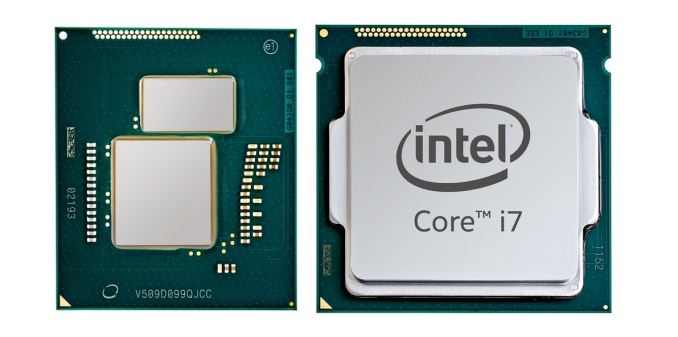
Intel’s integrated graphics processors (iGPUs) are the most widespread PC-class graphics adapters on the planet. Enthusiasts of high-performance personal computers do not use Intel’s iGPUs, but the world’s largest developer of microprocessors says that for mainstream and casual gamers its graphics solutions offer performance, which is comparable to that of inexpensive discrete video cards.
“For the mainstream and casual gamer, we have improved our Iris and Iris Pro graphics tremendously,” said Gregory Bryant, vice president and general manager of the desktop client platforms at Intel, at the J.P. Morgan Tech Forum at the 2016 International CES. “We have improved our graphics performance [by 30 times] from where it was five years ago. We believe that the performance of Intel’s integrated graphics today, what we offer in the products […], is equivalent to the performance of about 80% of discrete [GPU] installed base.”
Intel has been improving its integrated graphics cores at a rapid pace after the company cancelled its discrete graphics processing unit code-named Larrabee in 2010. Thanks to timely transition to newer process technologies, Intel could increase transistor budgets of its central processing units significantly every couple of years. As the company did not increase the number of general-purpose cores inside its mainstream CPUs for desktop and mobile personal computers in the recent years, the lion’s share of that additional transistor budget was spent on iGPU-related improvements.
Intel considers its code-named Clarkdale and Arrandale processors its first-generation CPUs with integrated graphics (which is not entirely correct since these CPUs had two dies: the processor die as well as graphics and integrated memory controller die). Back then, Intel’s most advanced iGPU featured 12 execution units (EU) with peak compute performance of around 43 GFLOPS. Since then, the architecture of Intel’s integrated graphics processors has evolved to accommodate new features and gain performance. Today, each EU features two ALUs that can execute up to four 32-bit floating point or integer operations per cycle (in fact, one of the two ALUs in Intel’s Gen8 EU also supports double precision 64-bit floating point operations). Intel’s latest microprocessors — Broadwell with GT3e and Skylake with GT4e graphics cores — have Iris Pro iGPUs with 48 and 72 EUs as well as peak compute performance of 883 and 1152 GFLOPS, respectively.
While Intel did not define what it considered to be the installed base of discrete graphics cards, it is obvious that the company compares its recent Iris and Iris Pro integrated graphics processors to discrete graphics adapters sold in the last five or even more years and which are currently in use.
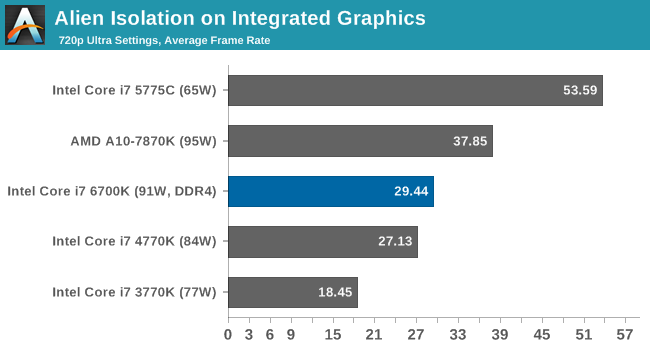
Intel’s latest integrated graphics processor found in its Skylake chips — the Iris Pro 580 with 72 execution units and 1152 GFLOPS compute performance — should outperform even more advanced discrete graphics processors. In fact, AMD's latest integrated graphics core also outperforms the low-end graphics card (albeit, by a small margin).
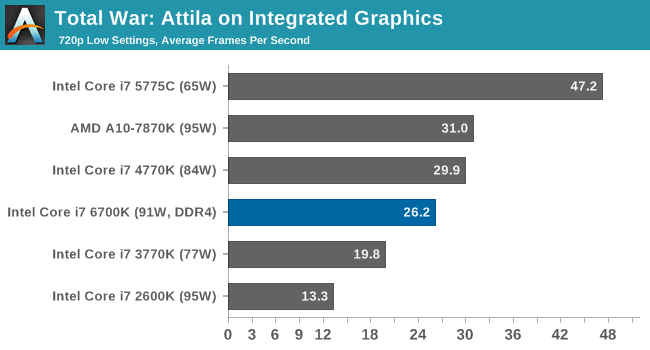

Because many people do not play demanding games that use the latest application programming interfaces (APIs), performance and features of Intel’s modern iGPUs may be enough for their needs. Moreover, since casual and even some mainstream gamers usually buy low-end graphics adapters, Intel’s Iris Pro 6200 and Iris Pro 580 can actually outperform such GPUs (or offer similar performance). It is not clear whether 80% of discrete graphics boards currently in use belong to the entry-level segment, but it evident that contemporary iGPUs are somewhat better than cheap video cards.
Even though enthusiast gamers do not use Intel’s high-end iGPUs, the company continues to thrive because of PC gaming. According to Intel’s management, sales of its Core i7-series microprocessors set records in Q2 2015 despite weak demand for personal computers overall. Moreover, Intel claims that shipments of high-end enthusiast-class hardware in general are at all-time high and growing. Intel sells not only powerful Core i7 CPUs with unlocked multiplier to demanding gamers, but also chipsets, solid-state drives, various controllers and other components for high-end PCs. As a result, the company takes advantage of increasing demand for powerful personal computers.
Source: Intel Investor Relations


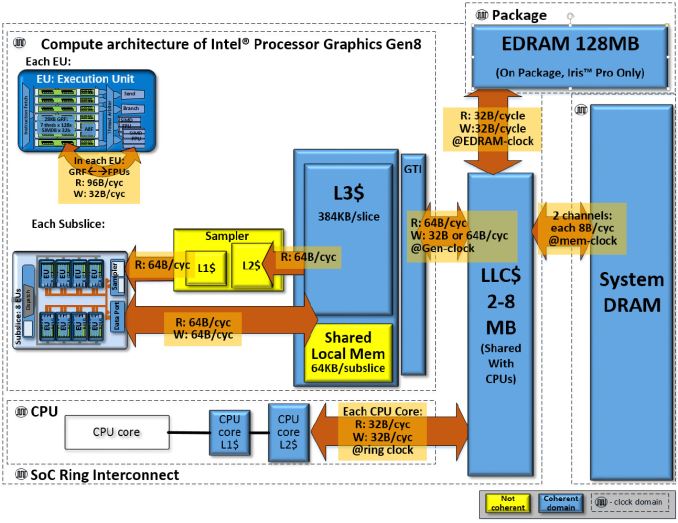
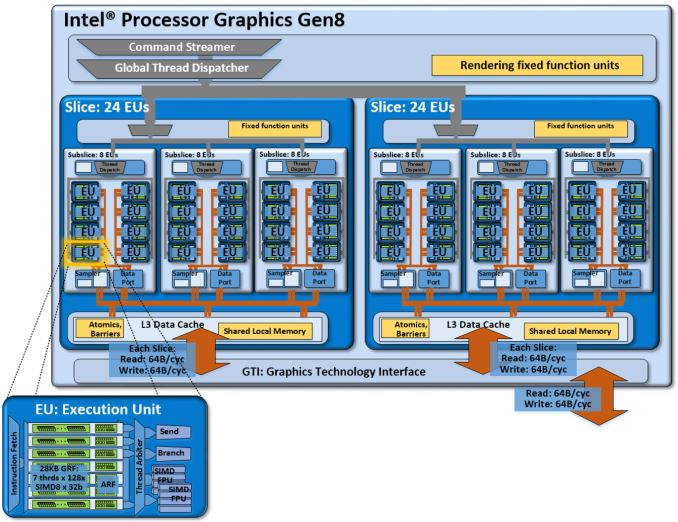








96 Comments
View All Comments
zlatan - Thursday, January 14, 2016 - link
Intel probably didn't test with D3D12. In this API their iGPUs are painfully slow.I didn't really know that Fable Legends how optimized for Intel, but an Iris Pro 6200 is two times slower than a Carrizo with 15 watt TDP.
nathanddrews - Thursday, January 14, 2016 - link
Source for that benchmark?I suppose that yes, technically Iris Pro is on par with a dGPU that costs $50, but it's still "not great".
BurntMyBacon - Monday, January 18, 2016 - link
Bigger issue for me is that they are talking as if i7-5775C Iris Pro represents the majority, or even some significant portion of the install base. The i7-6700K comes up short of AMD's IGP efforts, which are slotted in beneath their low end discrete cards, so the i7-5775C is the only chip in this article that may fit the statement. Most people getting a new computer are going skylake (6xxx series). There are some people upgrading existing Z97 boards with broadwell, but even if the entire DIY upgrade market went that route, that is a very small percentage of the install base. I have not seen a whole lot of broadwell in retail systems. This makes sense as people (and marketing departments) tend to gravitate to the "larger numbers" or "newness" of the skylake series. The brand new DDR4 is also an easy marketing differentiator. Given that the i7-5775C is a fair bit more expensive than the i7-6700K, I don't imagine that many of the uninformed would see any reason to pay more for an older processor. This is especially true when you take a look at the limitations of the platform and how many marketing bubbles the newer skylake platform gives you over the older broadwell platform. The informed crowd may see some of the benefits of the older chip despite the platform limitations, but they are often buying it to pair with discrete cards, so even if they do count towards the install base, they aren't always using them.ddriver - Thursday, January 14, 2016 - link
So the new mainstream is the mediocre of the previous era. And there I was, thinking society is improving.Gaming at a resolution, lower than the standard one, at below 60 FPS - that's not mainstream. That's entry level. Mainstream gaming would be at least at 1080p60, high end at 2k120 and up.
Not that anyone expected Intel to be objective and realistic about the GPUs they keep cramming into chips rather than extra cores or lower prices - things people actually need. iGPU should only be in up to i5 products.
jragonsoul - Thursday, January 14, 2016 - link
Honestly for the average persons 720p is what they game on. and a lot of games don't run game maxed out. That'es the enthusiast/high end PC crowd. Don't project your requirements on to the rest of gamers.That being said I do agree those people have no idea what they're missing. Or just don't care enough. I run a 2600k @4.5ghz with a 390x on a 1440p 144hz freesync monitor so I wouldn't be able to go back to 720 or even 1080 TBH.
ddriver - Thursday, January 14, 2016 - link
Mainstream is not your average casual angry birds gamer. The mainstream is really the "average" the "midrange". That's intel's idea - to prop up its entry level products as average, but that is straight out false advertising.So intel's very best GPU doesn't entirely suck at playing games at low resolutions and low framerates - but that ain't mainstream, that was the mainstream a long time ago.
haukionkannel - Thursday, January 14, 2016 - link
Mainstream are people who plays mine-sweep and solitaire with their computer. Intel GPU is fast enough to do that!ddriver - Thursday, January 14, 2016 - link
"Mainstream is current thought that is widespread"I highly doubt people playing mine sweeper are the bulk of gamers out there. The mainstream gamer is the midrange gamer - and intel's hardware is really entry level.
jragonsoul - Thursday, January 14, 2016 - link
More than 60% of steam user play on monitors LESS than 1080p (http://store.steampowered.com/hwsurvey) . "Mainstream" and "Midrange" do NOT mean the same thing. You can think that does but but they don't. I was a gamer on a very subpar/entry level build years because that's what I had. I have access to better now but back then I turned the fidelity down and lowered the resolution if I had to, it's what us gamers on a budget did.jasonelmore - Friday, January 15, 2016 - link
its because of the 25% who own those cheap laptops. I would bet half of that are duplicate owners, who own a desktop machine at home, and have a cheap gaming laptop they use to CS GO or Dota.Also the China and Korea market is on that same resolution
From the Hardware survey:
1366 x 768 26.47%
Everything other resolution below 1080p is 1-2% or less